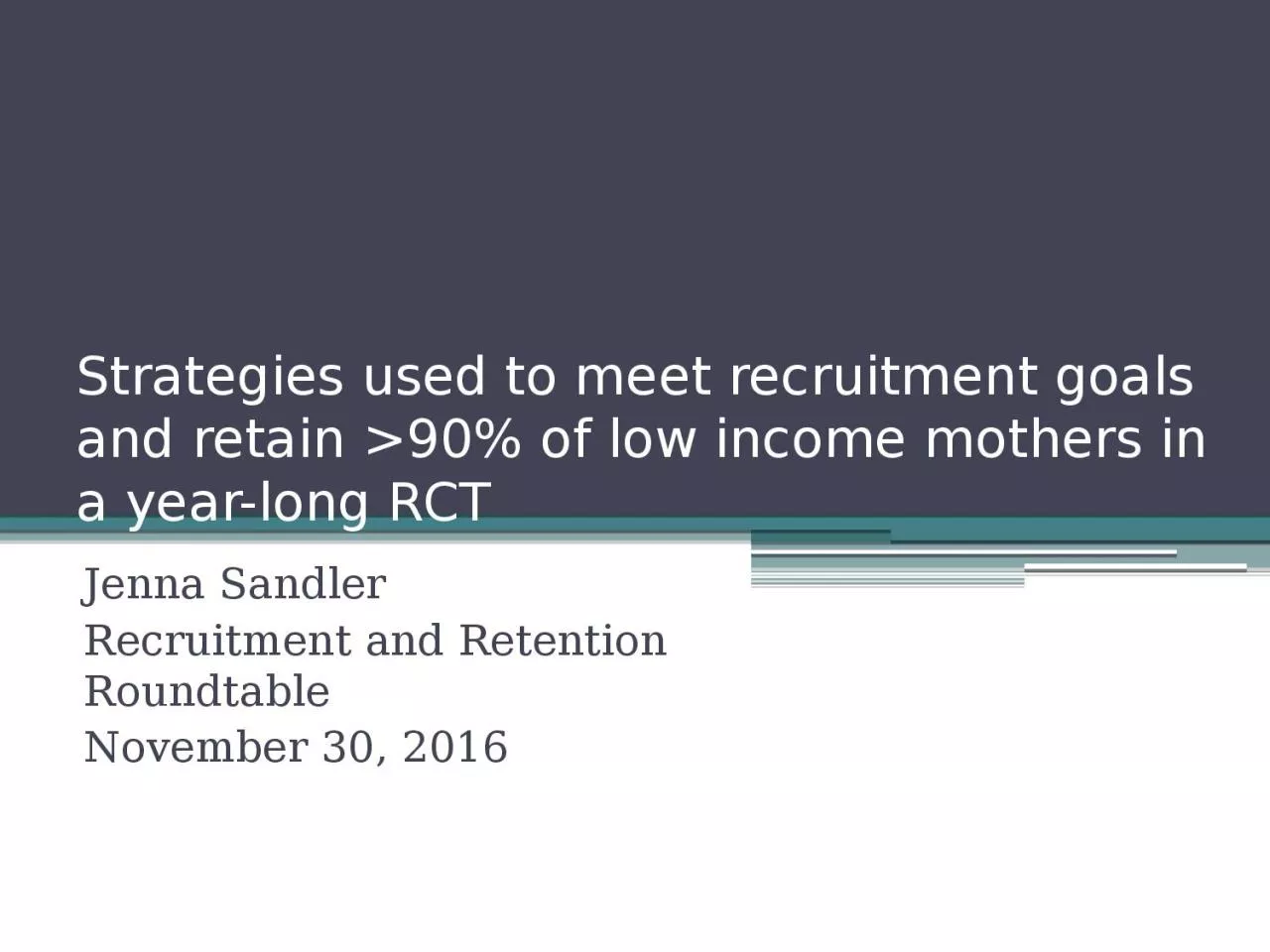

Jenna Sandler Recruitment and Retention Roundtable November 30 2016 Learning Objectives Understand the challenges to engaging diverse populations in research Implement strategies to meet recruitment milestones ID: 930267
Download Presentation The PPT/PDF document "Strategies used to meet recruitment goal..." is the property of its rightful owner. Permission is granted to download and print the materials on this web site for personal, non-commercial use only, and to display it on your personal computer provided you do not modify the materials and that you retain all copyright notices contained in the materials. By downloading content from our website, you accept the terms of this agreement.
Slide1
Strategies used to meet recruitment goals and retain >90% of low income mothers in a year-long RCT
Jenna Sandler
Recruitment
and Retention
Roundtable
November 30, 2016
Slide2Learning Objectives
Understand the challenges to engaging diverse populations in research
Implement strategies to meet recruitment milestones
Develop approaches to maintain high participant retention in research
Slide3Discussion question
In your own work, what do you see as barriers to participation of vulnerable populations in research?
Slide4Common barriers to participation of vulnerable populations in health-related research
Mistrust
Competing demands
Unintended outcomes
Lack of access to information
Stigma
Health insurance coverage
Legal status in the United States
George, S., Duran, N., & Norris, K. (2014). A Systematic Review of Barriers and Facilitators to Minority Research Participation Among African Americans, Latinos, Asian Americans, and Pacific Islanders.
American Journal of Public Health
,
104
(2), e16–e31.
Slide5Project Solve Context
RCT’s testing the efficacy of a problem solving intervention to prevent depression among low-income urban mothers
Study population:
Low income
Very diverse (75% racial or ethnic minority; about 50% born outside the US)
At risk for major depression
Over 50% had a history of trauma
Majority single mothers
Slide6Project Solve Research Assessments
Research assessments every 2 months over a one year follow-up period
By phone: 2, 4, 8, and 10 month
In person:
Baseline, 6
and 12 month
In person assessments conducted in the home or other community location
Slide7Project Solve Staffing Structure
Three distinct teams of research staff that work across projects
Recruitment team
Intervention team
Follow-up team
Slide8Recruitment strategies
Slide9Proactive outreach
Incorporating screening for study into current practices
“Loopback” recruitment strategies to capture missed referrals
Continuously obtain data on missed referrals and get permission to contact
Opt out letters
Slide10Getting in touch with potential participants
Flexible research staff
Evening, weekend hours
Call as soon as possible after receiving a referral
Loop back to referring provider about non-working numbers
Recognize that people are busy. Be persistent but respectful
On referral form, ask for preferred times to call and for preferred methods of contact
Call from non-BMC number
Staff cell phones
Slide11Building rapport
Re-visit the recruitment script often
Bilingual/bicultural staff are key
Slide12High quality informed consent process
Two way discussion
Provide opportunities for questions
Offer time for family
to discuss and
think it over
Slide13Recruitment of sites
Identify a champion at each site
Someone who cares about the research aims
Talk with this person every month
Go to them to troubleshoot as issues arise
Give
back
Use research team’s expertise to provide educational opportunities and resources
Slide14Close monitoring of recruitment progress
“Diagnose” why you’re not getting people into the study in the way you want to
Systematically track study flow from referral to enrollment
Make changes as needed
Slide15Retention Strategies
Slide16Prep to retention
Ensure that research participants fully understand what is
involved in the study
MacCAT
-CR
tool
Screen
out families who plan to move or travel for extended period of timeIf possible, have several steps before randomization
Contact on phone to gauge initial interest
Conduct home visit to conduct informed consent and baseline
Call next day to randomize (remind participants of what is involved and confirm that they would like to move forward)
Slide17Training RA’s
Importance of “being human” during research assessments
Personalize
visits
Be understanding about no-shows and cancellations
Same RA should do all visits for a participant to build a relationship
Slide18Be accommodating
Flexible hours/days
Flexible methods (phone, in-person, email)
Allow for rescheduling
Offer to skip a research assessment and call again for the next one
Slide19Strategies for keeping in touch
Utilize all methods you have permission to use
Text
Email
Alternate contacts
Social media (with appropriate permissions and steps to protect privacy)
If possible, provide cell phones to participants
Documentation
Maintain accurate and thorough contact information, including alternate forms of contact
Permission to access EMR
Update contact information at EVERY time point
Detailed contact logs
Slide20Strategies for keeping in touch
Consistent point person for each participant
Reminder
calls, especially if there is a gap between visits
Send birthday cards/holiday cards
Last resort strategies
Certified letter to tentatively schedule an interview
Find participants at clinic visitsPartner with another provider to coordinate a visit
Slide21Continuous quality improvement
Ask participants
for
feedback
If participant withdraws, ask for feedback and learn from the experience
Qualitative interviews at study completion
Track
major issues very closely
Loss to follow up
Participant withdrawals
Slide22Maintain accurate tracking systems
Interview “windows” with start and end date for each research assessment
Create a data tracking system that can easily query interviews that are currently due
REDCap
Don’t rely on Excel for big studies
Someone should be looking at the tracking systems daily
Weekly meeting with PI to review follow-up rates
Slide23Take home points
Most valuable strategies for Project Solve:
Discussion-based informed consent process
Flexible, dedicated research team with strong interpersonal skills and language capacity
Home visits
Texting
Alternate contacts
Meticulous tracking
Slide24Questions?